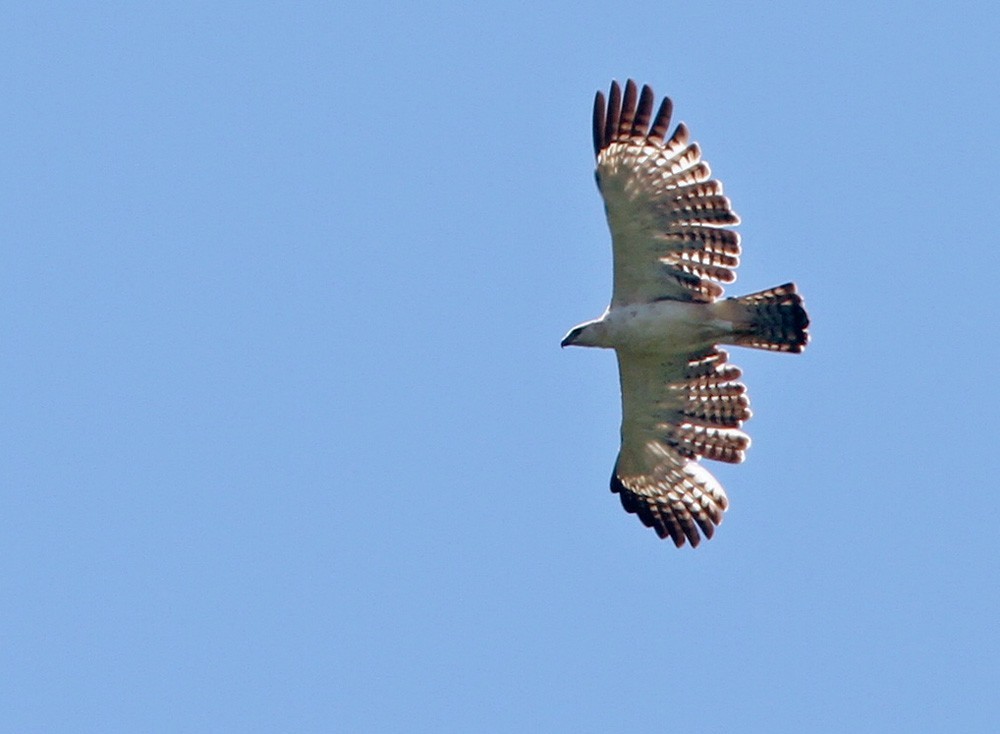Flores Hawk-eagle
A species of Old World Hawk-eagles Scientific name : Nisaetus floris Genus : Old World Hawk-eagles
Flores Hawk-eagle, A species of Old World Hawk-eagles
Botanical name: Nisaetus floris
Genus: Old World Hawk-eagles
Content
Description General Info
 Photo By Lars Petersson
Photo By Lars Petersson Description
Adults have dark brown upperparts, a brown tail with six bars, a white patch in the wings that is visible in flight, white underparts, and a white head with fine brownish streaks on the crown (many books erroneously illustrate adults with largely brown heads). Furthermore, they have sparse light dark markings about the thighs. The white patches at the upperside of the primaries are a species diagnostic. Furthermore, the tail has 6, not 4–5, bars. It has traditionally been treated as a subspecies of the changeable hawk-eagle; at least in part because of confusion over the true adult plumage of the Flores hawk-eagle, which resembles the juvenile of the changeable hawk-eagle. Unlike that species, adult and juvenile Flores hawk-eagles are quite similar. Unlike some changeable hawk-eagles and many other Nisaetus, Flores hawk-eagles lack a head crest. What data is available shows Flores hawk-eagles are a fair bit larger than the changeable hawk-eagle. The total length is usually reported at 75 to 79 cm (30 to 31 in) but may range from 71 to 82 cm (28 to 32 in). Claims it may measure as little as 60 cm (24 in) are probably due to confusion with other hawk-eagle species. The reported total lengths put in contention with the mountain hawk-eagle as the largest of all Nisaetus but the mountain species appears to significantly larger winged and more heavily built than the Flores species, which has the gracile and long-tailed form like the changeable hawk-eagle. However, no published weights are known for the Flores hawk-eagle. The wing chord of the Flores hawk-eagle is 430 to 462 mm (16.9 to 18.2 in). 
Nest Placement
Tree
Feeding Habits
Flores Hawk-eagle preys mainly on snakes, birds like rails, and possibly flying foxes, using a still-hunting technique from perches.
Habitat
The flores Hawk-eagle is typically found in the tropical rainforests of the Lesser Sundas region. Its habitat range extends from lowland forests to sub-montane environments, reaching elevations up to approximately 1700 meters. This species relies heavily on intact native forest ecosystems but has also been observed utilizing secondary forests, eucalypt woodlands, and agricultural areas, particularly when adjacent to large forests. The flores Hawk-eagle can also be seen in forested villages and occasionally forages in mangroves.
Dite type
Carnivorous
General Info
Feeding Habits
Bird food type
Species Status
Due to ongoing habitat loss within its small range, capture for the cage bird trade and persecution due to its habit of taking chickens, the Flores hawk-eagle is evaluated as critically endangered on the IUCN Red List of Threatened Species. Poaching may be ongoing and trappers may even come from other islands to kill these birds. However, the Flores hawk-eagle was once considered in western Flores be a "totem" or "empo," i.e., a human ancestor, and was not persecuted or killed but habitat destruction may have been long negatively effecting the species. Educational efforts have been undertaken to try to ensure local people's coexistence with this predatory bird. It is estimated that less than 100 pairs remain, based on a per pair occupancy of about 40 km (15 sq mi). A more specific estimate put the total at about 75 projected pairs, with 10 pairs on Lombok, 38 pairs on Sumbawa, and 27 pairs on Flores. 

 Photo By Lars Petersson
Photo By Lars Petersson